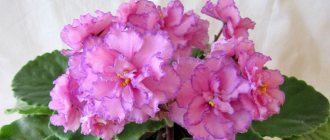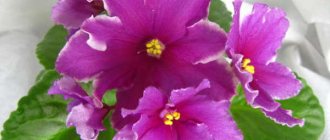What does a violet look like Wedding Bouquet
Violet Wedding bouquet is an incredibly spectacular flower. It was bred by K. Morev, a famous breeder. This variety gave rise to a sport called Our Wedding, as well as a seedling - violet Bride's Bouquet.
Violet Wedding Bouquet
A seedling may be practically indistinguishable from a varietal flower in appearance, but it would not be correct to compare them. Violet Bride, unlike Wedding Bouquet, has unstable varietal characteristics. At the moment, two varieties of this variety are known. They are distinguished by the shape of their leaves.
Attention! According to the description, the variety with pointed leaves is less capricious and is more fertile.
The flower got its name thanks to its large white flowers, similar to a bridal bouquet. The diameter of the flowers ranges from 5 to 6.5 centimeters. The flowers themselves look like double stars with a corrugated edge, white on top and silver on the back. The petal has a green border, which disappears over time.
If such a border appears again in the middle of flowering, then the air temperature in the room is too low. It will be enough to raise the air temperature so that the flowers become perfectly white again. When the bouquet blooms completely, it looks like an airy snow-white cloud above a green rosette.
Reviews about the variety and advice from gardeners on growing it
Lyudmila. I have never liked white flowers. Until I saw a photo and description of the Wedding Bouquet violet on one of the forums. I immediately fell in love with this snow-white foam of huge flowers. My Wedding bouquet delighted with its beauty for 5 months, and the flowers did not turn yellow, as happens with some other varieties. The second flowering was even more magnificent. Since then, other varieties with white flowers began to appear in my collection.
Lydia. A wedding bouquet is an excellent bloomer. I would say that this is not a bouquet, but a bouquet. The flowers are always dense, densely packed with petals. Each flower looks like a pompom. The color is simply gorgeous: white on the surface of the petals, and bluish-silver on the back. In the spring, when the flowers are just blooming, the petals have a subtle green around the edge. When it gets warmer and the flower is completely bloomed, there is no greenery. The violet's fertility is fantastic. There are many stepsons, and it propagates well by cuttings. The rosette is formed evenly. You just need to turn the pot all the time so that the size of the leaves is the same.
Features of violet care Wedding bouquet
Homemade bullfight violet - description of the flower
This variety of violet is very easy to care for. It does not require special conditions, you just need to follow a few simple rules.
In summer, the air temperature should not be higher than 24 degrees. Otherwise, the appearance of the flowers will change. They will look simpler and lose their shimmer and shape.
In winter, the temperature should not fall below 18 degrees. Otherwise, the plant will begin to freeze, and if watered abundantly, it will rot. A wedding bouquet loves light, but the flower must be protected from direct sunlight. You should not place it on a window facing south, because delicate flower leaves can get burned, and the roots can overheat.
Burn on the leaves
If all the windows in the house face south, then the flower must be shaded. If there is insufficient lighting, additional lighting will be necessary. It is best to install the flower on east and west windows.
Water for irrigation must first be settled and then frozen so that it becomes soft. Before use, the water is defrosted and warmed to room temperature. Too cold water has a bad effect on the root system of the plant.
Important! You should water your violet no more than once or twice a week to prevent overwatering.
During the period of plant growth and development, when a rosette begins to form, it is necessary to provide the flower with fertilizers containing nitrogen. As soon as the buds form, you need to exclude nitrogen and include phosphorus and potassium in the bait. There is no need to fertilize more than once every 2 weeks. If the flower is sick, you should wait a while with feeding.
Advantages and disadvantages
Mysterious chanson violet: care, photo and full description
Violets in the bride’s bouquet will ensure the sophistication and romantic mood of the chosen one. A delicate flower in white, blue or red with fragile velvet petals on a snow-white background of a dress is an excellent solution.
The most common are purple violets. This is a symbol of peace when two opposite spectrums - blue and red - merge into one. It is very symbolic for a wedding, when the feminine and masculine principles come together. Combinations of violets have been successfully used:
- purple;
- pink;
- white.
The color purple is used very rarely for a wedding dress, but creating an interior in purple tones is always impressive. By adding flowers for the bride and a boutonniere for the groom in the same tone, you can complete the scheme. The spring mood will reign throughout the celebration, giving positive emotions to everyone present.
Today, the color of lilac is loved by designers all over the world. However, these fragile representatives of the flora require especially careful care of plants.
After all, it is important to maintain their freshness throughout the ceremony. Therefore, it is important to ensure that the violets receive maximum moisture before the start of the event.
When and how does it bloom
Description of the flower variety violet Duchess Lux
On average, eight to ten months pass from cutting to flowering. Violet blooms from one to three months. Flowers replace each other quite quickly. Some fade, while others bloom. Therefore, we can say that the Wedding Bouquet violet blooms almost all year round.
The rosette itself is very compact, with four to five buds on each peduncle. The leaves are green, rounded. Flowers are always dense, with a large number of petals. Perfectly shaped rosette.
Diseases
All diseases arise due to violation of the rules of care. Low temperatures and stagnant water in the soil are detrimental to “Wedding Bouquet”. The plant may suffer from late blight. Usually in this case it cannot be cured. The flower is destroyed along with the soil.
If overwatered, the violet may rot. Special solutions sold in flower shops help with rotting.
Pests do not often settle on the plant. But if this suddenly happens, it is necessary to use drugs that destroy specific insects.
The “Wedding Bouquet” variety of violets will decorate any room with its exquisite look. The beauty and magnificent forms of the plant will not leave your household indifferent. Refinement and unpretentiousness are the main criteria for growing this plant.
How to propagate violets Wedding bouquet
Violet Black Pearl - description of a home flower
There are several options for propagating Wedding Bouquet violets. One of them is using cuttings. You need to use the leaves of the middle row of the rosette. You can immediately place the leaf cuttings in prepared loose soil, or you can first put them in water and wait until the roots appear.
Rooting cuttings in water
Within a month, babies appear on the cuttings. You shouldn’t separate them and replant them right away. You need to wait until the leaves become 3-4 centimeters in diameter.
To protect the young rosette, it is recommended to cover it with a transparent cap during rooting. After new leaves appear, the cap can be removed.
Another method of propagation is growing from a stepson. Violet Wedding flower often throws out daughter rosettes, which must be removed immediately. There should only be one outlet in the pot. If both mother and stepson grow in the same pot, the flower will not bloom. The stepson is carefully separated from the flower and transplanted into special soil.
Growing from seeds
You can also grow violets from seeds. To do this, the seeds must first be prepared.
First, they are mixed one to one with crushed charcoal, and then, in the same proportions, with sand. In this case, the mixture must be shaken thoroughly.
For planting seeds, special phyto-cassettes with a lid are best suited. First, drainage is poured into the container, then sand, sphagnum moss and finally soil. Next, the seeds are planted on moist, pre-prepared soil. Cover with a lid and place in a warm place, out of direct sunlight.
Violet blossom
Violet Black Pearl - description of a home flower
You can describe violet flowers endlessly. The inside is dazzling white, sometimes with a green border. Flowers can reach a diameter of 7 cm. When all the buds bloom, it seems that it is one large spherical flower.
There are two types of sockets:
- The first one has rounded leaves; a green border most often appears on such leaves. A plant with such forms is very picky about the quality and quantity of moisture. If watered incorrectly, it stops blooming.
- The second one has straight, sharp leaves and is less capricious. It is a spore of the main plant.
Flowering lasts about 3 weeks, the next one can be expected in 2-3 months. For the beauty of violets, it is enough to follow all the rules, which include: lighting, watering and timely feeding.
Transplantation after purchase and during reproduction
At the first transplant and up to three years, a violet with part of the old soil is placed in a new pot. First, drainage is placed at the bottom of the pot, which should fill it by a third. Next, the flower is carefully installed and soil is added. When the violet is three years old, replanting is performed with a complete replacement of the soil in the pot.
Important! On the day of transplantation, the plant does not need to be watered, and after the first watering, you need to add a little more soil around the violet trunk.
It is necessary to renew the soil and change the pot to a larger one when replanting the Wedding Bouquet every spring. There are now quite a few types and brands of ready-made soil for violets sold in stores. It is quite suitable for transplantation.
However, if you have time and desire, you can prepare the mixture yourself. To do this you will need:
- five parts of leaf or turf soil;
- three parts peat;
- one part sand.
Verniculite (10% of the total volume), ash and sphagnum moss are also added here.
Gradually increasing the size of the pot by 1 centimeter when replanting, you need to ultimately settle on a pot with a diameter of 11 centimeters. No further enlargement of the pot is required. Ideally, the rosette of a flower should be three times larger than the diameter of the pot for the flower to feel comfortable.
Before transplanting, you need to carefully examine the plant. If upon inspection dry or limp leaves, flowers and rotten roots are found, they must be removed. It is better to make all cuts with a sharp knife. Next, you need to crush a couple of tablets of regular activated carbon into powder and treat all the sections with it. If after transplantation, the leaves of the plant do not touch the ground, but are located almost at the same level with it, then everything is done correctly.
Botanical description
Uzumbara violet (or Saintpaulia) “Bride's Bouquet” was bred by Russian breeder Konstantin Morev. It is rightly considered one of the best varieties in his collection. Morev’s “handwriting” is easily recognizable among violet growers - all his creations have compact symmetrical rosettes and lush, large star-shaped flowers with strongly corrugated edges, making up dense “caps”.
“Bride’s bouquet” or, as it is also called, “Wedding bouquet” was no exception. The variety is distinguished by snow-white multi-layered terry-type “stars” with a slight bluish tint in the center and a soft green border. The color of the violet depends on the degree of opening of the buds and the air temperature.
At the beginning of flowering, and this usually happens in the spring, when the apartments are still cool, a pronounced lettuce border is noticeable on the petals. However, as the buds bloom and the house gets warmer, the green tint becomes less common. Until, finally, the petals acquire an even white tone.
To maintain a spectacular border, it is recommended to maintain the room temperature no higher than 20 - 24ºС.
The reverse side of the petals is painted in a rare silver-blue hue, creating a light hazy effect. This feature immediately distinguishes Morev’s “Bride’s Bouquet” from analogues bred by other breeders. Another characteristic difference is the strong peduncles, “hovering” above the foliage and giving the plant airiness.
The “Wedding Bouquet” impresses with the size of its elegant, but surprisingly voluminous “cap”. The diameter of the flowers in it ranges from 4 to 6.5 cm. The result is a spectacular contrast with a neat, small rosette consisting of rich green leaves with a loosely quilted texture.
Features of the variety
“Wedding” Saintpaulia is one of the most beautifully flowering varieties. Terry stars open very quickly and continue to please the eye for 2 – 3 weeks. At the same time, the plant constantly produces new buds, larger than their predecessors. Usually a violet has 5 peduncles, each of which has at least 4 luxurious terry “stars”.
A fully blossomed Saintpaulia looks like a round bouquet with a loose, loose structure, fully justifying its name. Violet growers unanimously recognize it as the best among white-flowered standards. In addition to its unique beauty, the good adaptability of the plant, which is comfortable in the same conditions as its owners, is valued.
Having noticed that Saintpaulia “Bride’s Bouquet” is sick, drying out or, on the contrary, rotting, you need to pay attention to the microclimate in the house - it is also unsafe for human health.
The snow-white beauty begins to bloom already 8–10 months after cuttings. Those who encounter this variety for the first time are surprised by the rapid appearance of the first buds, as well as by their splendor and large number. Flowering periods are repeated every 1 to 3 months, depending on the conditions created. Like other representatives of the Gesneriev family, the Morev violet does not tolerate heat well. At high temperatures, it may not bloom at all, or instead of double buds it may produce smaller simple ones.
Saintpaulia shoots abundantly, which can be beneficial for flower growers. When propagated by daughter rosettes, varietal characteristics are better preserved. However, untimely removal of stepsons reduces the abundance and quality of flowering.
There are 2 subspecies of “Wedding Bouquet” - with rounded and pointed leaves. In the second case, we are talking about sports (varietal mutation). Violets with sharp leaves are stronger and more prolific than their counterparts; it is recommended that novice gardeners pay attention to them.
Possible problems in growing
If you do not follow simple rules for caring for a Wedding Bouquet violet, you can expose the plant to many diseases.
Note! The flower is difficult to tolerate various types of diseases. You need to carefully monitor changes in the growth, development and appearance of the violet. Then you can notice the problem in time and have time to save the flower.
The main causes of Wedding Bouquet disease are excessive watering and non-compliance with temperature conditions. Failure to do so can lead to the development of fungal and bacterial diseases such as:
- late blight,
- fusarium,
- gray rot,
- rust,
- powdery mildew.
Gray rot
You can save a flower only if you immediately recognize the disease. The sick flower needs to be replanted urgently. Trim the affected leaves and roots, and sprinkle the cut areas with charcoal, having previously crushed it.
In addition to diseases, violets can be attacked by pests:
- scale insects,
- aphid,
- whiteflies,
- nematodes,
- scale insects,
- mites.
Note! To control pests, once a week you need to treat the leaves and soil with insecticides (Aktara, Fitoverm, Alatar, etc.). You need to repeat the procedure 3 times.
To summarize, it is worth noting that the Wedding Bouquet violet, which was developed by K. Morev, is suitable even for those who are very far from floriculture. It does not require special care, and if simple rules are followed, it can delight others with beautiful snow-white flowers almost all year round.
Contents in room culture
For Saintpaulia to maintain spectacular decorativeness and health in indoor culture, care regimens according to the classical scheme, taking into account minor nuances, :
- It is best to place violets on windowsills facing western or eastern directions . When positioned on the northern window, lighting with natural spectrum lamps is required; on the southern window, slight shading in the heat is required;
- It is better to water in small doses , after preliminary drying of the upper tier of the substrate;
- Feeding should only be carried out when necessary;
Violets must be properly cared for. - Lighting must be provided for a long time, natural nature, diffused spectrum;
- temperature must be maintained within +20 + 24°C;
- Suitable soil is nutritious, well aerated, permeable; with mandatory drainage;
- transplantation using a gentle transshipment method, except in unforeseen cases.
What varieties are cultivated at home?
At home, simple violets of the industrial group, variegated and collection ones are grown. Beginners are advised to start simple violets to gain experience in caring for them. An experienced florist can already grow complex breeding varieties. A huge number of species are grown at home. Experts have developed about thirty-two thousand varieties of indoor Saintpaulias, differing in many parameters: color, shape, leaf structure and rosette.
About twenty species of Saintpaulia grow in the wild. In natural conditions there are:
Velvet Saintpaulia
Velvet Saintpaulia
On the front side, the leaves are painted green, and the back side has a reddish tint. The inflorescence is made up of purple flowers with a dark central part.
Violet flower Saintpaulia
Violet flower Saintpaulia
Short stems bear blue-violet flowers and rich green heart-shaped leaves. The diameter of the rosette can reach sixty centimeters.
Saintpaulia Grote
Saintpaulia Grote
Belongs to the ampelous varieties. The pubescent leaves take on a rounded shape. The lilac-blue flowers do not grow more than two and a half centimeters.
Diseases and pests
Infection with fungal infections occurs if Sempolia is kept in a cold room with high humidity for a long time. Or with prolonged overflow, as well as using too cold water. Morev’s “Wedding Bouquet” is especially often affected by late blight. This is a serious disease that almost always leads to the death of the plant.
A clear symptom: the flower dries out, although the soil is quite moist. The leaves lose their tightness and quickly wither; brown spots appear on the stem at the roots - a sign of rotting. A sick flower must be immediately isolated from the rest. In the early stages of infection, it is transplanted into a fresh substrate and treated with trichodermin or foundationazole. Additionally, you can use the Infinito fungicide.
To preserve the variety, healthy, strong leaves are separated and used for cuttings. When transplanting, the earth mixture is sterilized, and superphosphate is added to it for prevention. In the later stages of all fungal diseases, the flower is destroyed, and the place where it stood is thoroughly washed with any cleaning agents. It is better to throw away the pot so that the spores are not passed on to its new “inhabitants”.
To protect against pests, Sempolia is treated with broad-spectrum insecticides, for example, Fitoverm, Aktara or Fufanol.
Reproduction
The snow-white variety Moreva is very prolific. It can be propagated either by leaves, which will delight a large number of children, or by stepson. Since sempoli does not apply to Chimeras, both methods give the same result; you need to choose the one that is more convenient in a particular case.
Cuttings
Separated leaves easily take root and are capable of producing 3–4 full-fledged rosettes in the future. To obtain optimal results, you need to take planting material from the second row. The lower leaves of the rosette are too old and rarely reproduce, while the upper leaves are young and not yet capable of vegetation.
Experienced gardeners immediately root cuttings in loose soil, but it is better to let the roots grow in water. Then, if the cutting begins to rot, you can notice it in time and make a new cut. Activated carbon is added to the water.
4 - 5 weeks after planting, babies appear. As soon as the starters (young plants) reach a leaf size of more than 3 cm, they are carefully removed from the “mother” into pots with a diameter of 5 cm. New “baby” rosettes need a greenhouse. It is usually made from a plastic glass. When, after transplantation, the plants begin to produce fresh leaves, the cover can be removed.
Stepsoning
The appearance of daughter rosettes on the plant threatens to stop flowering. To prevent the sempolia from wasting energy on the stepchildren, they must be removed in time. Using a toothpick, scalpel or tweezers, side shoots are removed from the axils of the lower leaves and rooted in a peat tablet, constructing a greenhouse from a disposable glass or plastic bag.
After about a month, the stepchildren can be transplanted into a small pot, “grabbing” part of the tablet. It is best to use a ready-made substrate for violets - it already contains all the components necessary for proper growth. The soil mixture must be loosened well.
History of the variety
Violet "le-beautiful creole"
The Wedding Bouquet variety appeared thanks to the breeding work of Konstantin Morev.
Konstantin Lvovich Morev is a student of the world-famous Russian breeder Boris Mikhailovich Makuni. Breeding work is carried out using the latest technologies that appeared in the 21st century.
Konstantin Morev’s varieties are not inferior to foreign ones
He pays special attention to multi-colored plants with clear strokes of prominent shades
Master Saintpaulias are characterized by a compact rosette of leaves, unusual colors of petals, lush, long-lasting flowers in a cluster arrangement.
Based on the Wedding Bouquet variety, breeder L. Pak developed the “Our Wedding” variety, which is a sport with a chimeric coloring.
Description and characteristics of indoor violets
Violet is a small plant with a short stem. Numerous hairy leaves of various shapes and colors extend from it on long petioles. They are rounded or heart-shaped, reaching a length of 8 cm. Saintpaulia flowers are 3 cm in size and grow in inflorescences of several pieces. The coloring is infinitely varied; some varieties, in addition to the main color, have borders, dots, stripes and spots on the flowers. They have no smell.
Saintpaulia or Uzambara violet
Saintpaulia is classified according to many parameters, in particular by the following:
- socket size: microminiature, miniature, semi-miniature, standard, large;
- flower size: small-flowered, medium-flowered, large-flowered, extra-large-flowered;
- type of flowers: simple, semi-double, double;
- shape: pansy, star, round flowers, bell, wasp, spider;
- color: plain, two-tone, two-color or multi-color;
- leaf shape: round, oval, heart-shaped, elongated;
- leaf type: boys, girls;
- edge of the sheet: rounded, entire, jagged, corrugated, wavy, torn.
Transfer
This operation is performed annually, in early spring. The pot is replaced with a larger one, but make sure that its diameter is 2.5 - 3 times smaller than the rosette. The maximum size of the container should not exceed 11 cm.
Instead of purchasing a substrate, you can prepare the mixture yourself:
- 5 parts of deciduous soil and turf;
- 3 parts peat;
- 1 part sand.
But it is still better to use a special primer. It is also recommended to add 10% vermiculite, sphagnum moss and wood ash to any soil mixture.
Until the age of 3, the flowers are transferred, that is, transferred to a larger pot with a lump of earth in which they grew before. Then a full transplant is carried out.
How to make a composition with your own hands
If the bride wants her image to be original and unique, she can independently create a flower arrangement for herself and a boutonniere for the groom. Some tips for combining violets will help you get a great result:
- The use of double snow-white flowers with a blue edging on the petals will combine favorably with the girl’s snow-white decoration.
- A variety of terry white violet, the middle of which has a blue tint, looks great.
- Using violet varieties to create a wedding bouquet of flowers like white stars with wavy petals is the most common arrangement option.
- Blue violets will add elegance and freshness to the composition.
- Choosing a violet wedding bouquet in red tones will ensure the extravagance of the ceremony. This type of violet for creating a wedding bouquet can be effectively combined with bright makeup by choosing lipstick to match the flowers.
The bride can not only hold a small bouquet, but also attach it to her muff if the celebration takes place during the cold season. Some outfits are specially equipped with eyelets for bouquets. You can strew the tablecloth on the festive table with violet petals so that the interior looks harmonious with the image of a couple in love.
How to keep flowers fresh
Florists recommend immersing plants completely in water to saturate them with moisture as much as possible. Additionally, you will need to cover the plants with paper and leave them in a cool room 2 hours before the ceremony. Trim the stems at the bottom by 2 cm. Before placing flowers in the garden, make longitudinal cuts on the stems. During the event, you can spray the flowers with water. Wrap the ends of the shoots so that they do not lose moisture.
By following these recommendations, you will be able to preserve the fresh appearance of violets for a long time.
Description of the violet tricolor plant
Tricolor violet or pansy (lat. Víola tricolor) is a herbaceous plant common in Europe and temperate regions of Asia. The plant belongs to the species of the genus Violet of the Violet family.
The popular name is Ivan-da-Marya, but plants of other genera are also called this way, for example, the oak grove (Melampyrum nemorosum) from the Norichnikov family. Other popular names for the plant: brother-and-sister, moths, field brothers, half-flower, axes, three-flowered.
In gardening, pansies are also often called the hybrid Wittrock violet (Viola x wittrockiana Gams ex Hegi), which has larger, brighter flowers.
What does a tricolor violet look like?
Violet tricolor is an annual or biennial herbaceous plant. The stem is straight or branched, from 5 to 45 cm in height. The leaves are simple, the upper ones are elliptical, the lower ones are ovate.
The flowers are beautiful, the upper petals are mostly purple or blue, the lower petals are yellow and white. Flowering time occurs in April, fruits ripen in June.
In June, the elongated three-headed top of the plant ripens, storing seeds that promote further propagation of the flower. The tricolor violet is much smaller than its usual garden counterpart and is always painted in three different colors.
Where does tricolor violet grow?
The plant is widespread in Eastern Europe, Siberia, the Far East, Scandinavia, and Asia Minor. In the “Atlas of areas and resources of medicinal plants of the USSR”, tricolor violet is described as a European species, found in Siberia only as an alien plant.
The northern border of the distribution area extends to the cities of Kirovsk, Murmansk, Kandalaksha, White Sea, Ponoy (Kola Peninsula), Mezen, Ukhta, Pechora, Vorkuta. Further, the border goes along the 60th meridian to Yekaterinburg, wedging in the east near Tobolsk. Individual locations are known in the vicinity of Tomsk, in the Kemerovo region, Krasnoyarsk and Altai territories, where tricolor violet is found as a weed.
The southern border of the range runs through Chelyabinsk to Izhevsk, then through Samara, Saratov, Volgograd, somewhat south of the Tsimlyansk Reservoir, heading to Rostov-on-Don, then through Donetsk to Zaporozhye and the Carpathians.
In the west, the border of the range goes beyond the former state border of the USSR. In the northwest it reaches the coast of the Baltic Sea, along the southern shore of the Gulf of Finland it reaches St. Petersburg, then goes north along the border with Finland to Murmansk.
In Crimea, only one location of the violet is known - in the valley of the Kacha River.
It is found on fertile soils in meadows, among bushes, along forest edges, in pastures and old fallow lands. Wild plants can be found in old parks, gardens, former estates, and near roads.
violet grass
As a medicinal raw material, the herb of violet tricolor is mainly used, and occasionally the flowers of the plant. Due to its unique composition, the plant can be used to treat a wide range of diseases.
The scope of application of violets is determined depending on the specific part of the plant. The leaves are used as various poultices, and the flowers are used for tinctures. In traditional medicine, violet is used as an expectorant, and in folk medicine, the plant is used in the fight against sexually transmitted diseases, nervous diseases, cystitis, arthritis, stuttering, problems with the gastrointestinal tract and angina.
Tricolor violet is used for dental purposes, prevents inflammation and has an antiseptic effect. In pharmacies, violet is sold in the form of various syrups, extracts, gelatin capsules and powders.
How to form a bush correctly
Thanks to the harmonious rosette, the variety does not require formative pruning . It is only important to promptly remove dried leaves, faded buds and overly elongated flower stalks.
The “Wedding Bouquet” violet has a truly unique appearance. A pot of this plant can be a good gift for any occasion.
Give joy to a loved one, and in addition, he will receive many pleasant moments while caring for this violet and admiring the beautiful bloom of his favorite flower.











